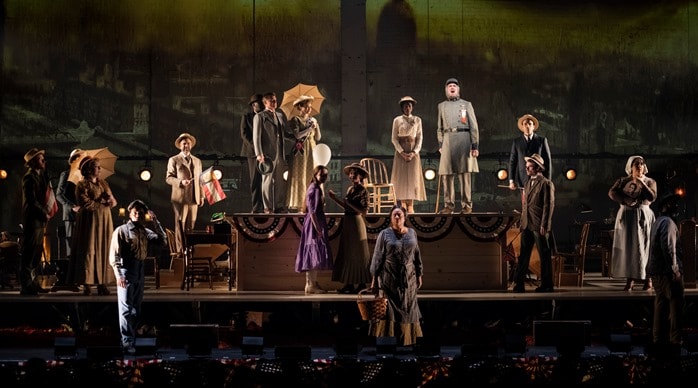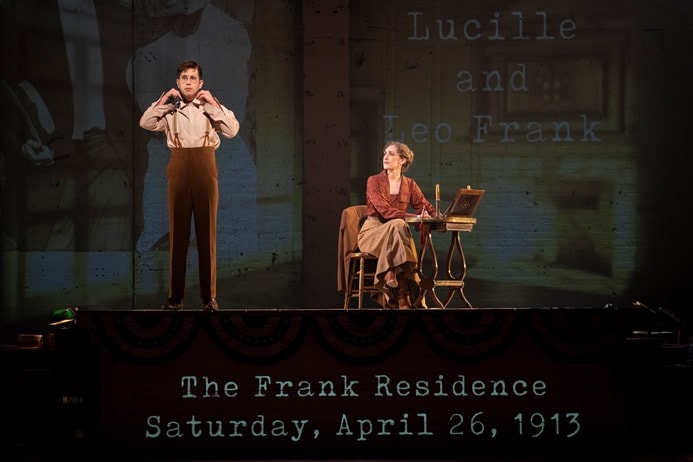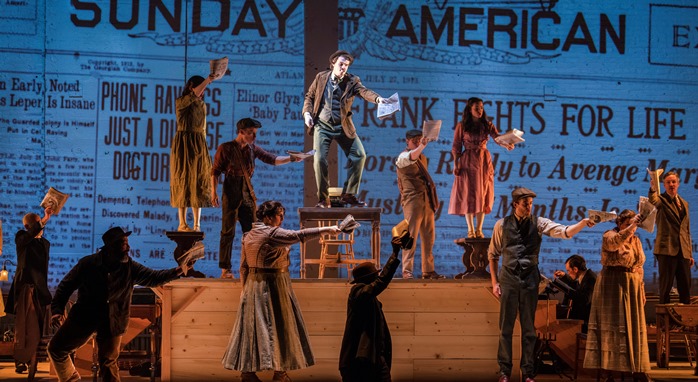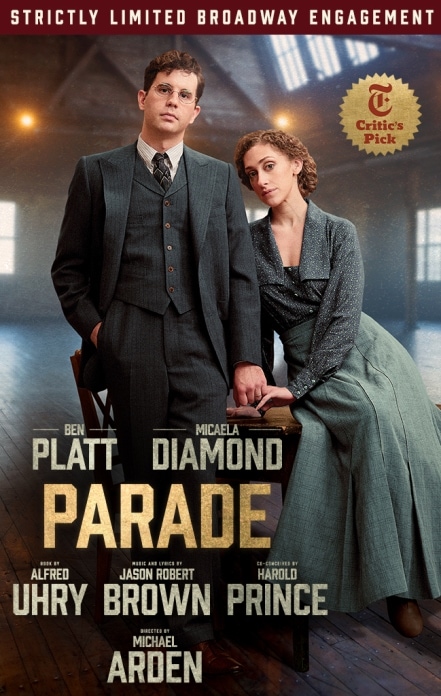The Broadway transfer of New York City Center’s reworked, highly acclaimed, sold-out revival of Parade – the award-winning musical drama by Alfred Uhry (book, co-conceived by Harold Prince) and Jason Robert Brown (music and lyrics), which made its brief Broadway debut in 1998 – is playing a strictly limited engagement at the Bernard B. Jacobs Theatre through early August, so get your tickets while you still can to this rich and timely masterpiece about a horrific miscarriage of justice in our country’s history.

Based on actual events of 1913-15 (which led to the rebirth of the defunct KKK and the founding of the Anti-Defamation League), the momentous production, directed by Michael Arden, recounts the true story of Leo Frank, a Brooklyn-bred Jewish factory manager living in Georgia, who was tried, convicted, imprisoned, and sentenced to death by hanging for the rape and murder of thirteen-year-old factory worker Mary Phagan, in a deplorable judgment that was founded in hatred, bigotry, coerced false testimonies, and political ambition, and sensationalized by the media. A subsequent investigation and review of the case, just prior to his scheduled execution, resulted in the commutation of his death sentence to life in prison by the outgoing Governor, which incited Frank’s kidnapping from his jail cell and hanging from an oak tree by a violent anti-Semitic vigilante lynch mob. But along with the show’s shocking tragedy is its growing love story between Leo and his wife Lucille, who stood by him, believed in his innocence, championed his cause, and provides beautiful uplifting moments of much-needed happiness amidst all the anguish.
To help the audience follow along with the many characters, dates, locations, and details, and to underscore the historical verity of the narrative, projections (by Sven Ortel) across the back wall and on the front of an elevated central platform contain vintage photos and names of the real-life figures, sites, newspaper headlines and articles, and other well-researched factual information that trace its chronological development, including the final update that the case was reopened for further investigation in 2019.

Ben Platt (who will not perform on May 19-20) and Micaela Diamond lead a full company of more than two dozen – each appearing as a significant named character and given a moment in the spotlight – in their starring roles as the newly married Franks. He is an educated and hard-working, emotionally distant and awkward Yankee outsider who feels out of place in the Deep South, as expressed in his initial song “How Can I Call This Home?” and his noted preference for “Shalom” over “Howdy.” Born and raised in Georgia (though her accent could use some dialect coaching), she is an undervalued wife, distressed by his remoteness (“Leo at Work/What Am I Waiting For”), but remaining strong and steadfast in her devotion and confidence in her husband (“You Don’t Know This Man”), and ultimately convincing him of the depth of their love (leaving them to lament “All the Wasted Time”). Both bring their extraordinary voices and empathy to the moving solos and duets and bring down the house with their showstopper “This Is Not Over Yet” (there were several minutes of sustained applause at the performance I attended, and, I assume, at every performance).
The supporting cast also contributes key points in the narrative, opposing perspectives of the characters, and telling segments of song and dance, from the opening number of a young Confederate soldier (played by Charlie Webb) extolling his love for “The Old Red Hills of Home,” to the enacted falsified condemnatory statements of three young female employees at the factory (Iola Stover, Essie, and Monteen, portrayed respectively by Sophia Manicone, Emily Rose DeMartino, and Ashlyn Maddox) in “The Factory Girls/Come Up to My Office,” to the lively and acerbic “A Rumblin’ and a Rollin’,” in which Riley and Angela (Douglas Lyons and Courtnee Carter) – two members of the household staff at the Governor’s Mansion – mordantly observe that there wouldn’t be such an uproar if a Black girl had been murdered or a Black man sentenced to hang.

Other notable featured performances, portraying Frank’s chief antagonists, are delivered by Paul Alexander Nolan as the ambitious, unscrupulous, and hateful prosecutor (and future Governor) Hugh Dorsey; Howard McGillin as Judge Roan, who presided over the sham trial and pronounced Frank’s death sentence; Manoel Felciano as the incendiary bigoted agitator Tom Watson, who inflames the crowd; Jay Armstrong Johnson as the drunken junior reporter Britt Craig, who sensationalized the story to advance his own fledgling career; and Jim Conley (Alex Joseph Grayson), an escaped convict and janitor at the factory, believed by many to have been the actual rapist and murderer, who gave the most damning, but not always credible, testimony against Frank (“That’s What He Said”).

Additional key players include the Franks’ distraught housekeeper Minnie McKnight (Danielle Lee Greaves), compelled by the authorities to lie under oath about Leo; the innocent young victim Mary (Erin Rose Doyle); Frankie Epps (Jake Pedersen), a boy interested in taking her to the movies that night; and Governor Slaton (Sean Allan Krill), who hosts a lavish ball with his wife Sally (Stacie Bono), dances with all their guests (choreography by Lauren Yalango-Grant and Christopher Cree Grant), and is convinced by Lucille to review her husband’s case, which he does out of a sense of moral conscience and concern for the truth, contrary to his own self-interest with the voting populace. Rounding out the consistently compelling company are Kelli Barrett, Eddie Cooper, Florrie Bagel, Max Chernin, Christopher Gurr, Beth Kirkpatrick, William Michals, and Jackson Teeley, all capturing the essence of their diverse characters.
Costumes by Susan Hilferty and hair and wigs by Tom Watson recreate the authentic look of the era. And Dane Laffrey’s set, with a raised wooden platform box in the center of the stage, flanked by rows of chairs on both sides and hung with American flags, cleverly functions as everything from the Franks’ home to the courtroom to the jail cells in which he was held, and the site on which he was lynched, enhanced by Heather Gilbert’s lighting, sound by Jon Weston, and the recurrent appearance of Confederate flags. While I found some of the slow-motion segments and the apparition of Mary Phagan on a swing descending from above to be unnecessary gimmicks, the entirety of the show, the lush orchestrations (by Don Sebesky and Jason Robert Brown), and the beautiful performance of the music by the first-rate live orchestra (led by music director and conductor Tom Murray) epitomize the very best of Broadway.
If there is any doubt as to the contemporary relevance of this profoundly affecting production of Parade, one need only consider the current rise in anti-Semitic hate crimes and the angry opening-night protest outside the theater by a faction of Neo-Nazis. Sadly, in the words of the song, “This Is Not Over Yet.”
Running Time: Approximately two hours and 30 minutes, including an intermission.
Parade plays through Sunday, August 6, 2023, at the Bernard B. Jacobs Theatre, 242 West 45th Street, NYC. For tickets (starting at $59, plus fees), go online. Masks are optional but recommended.





